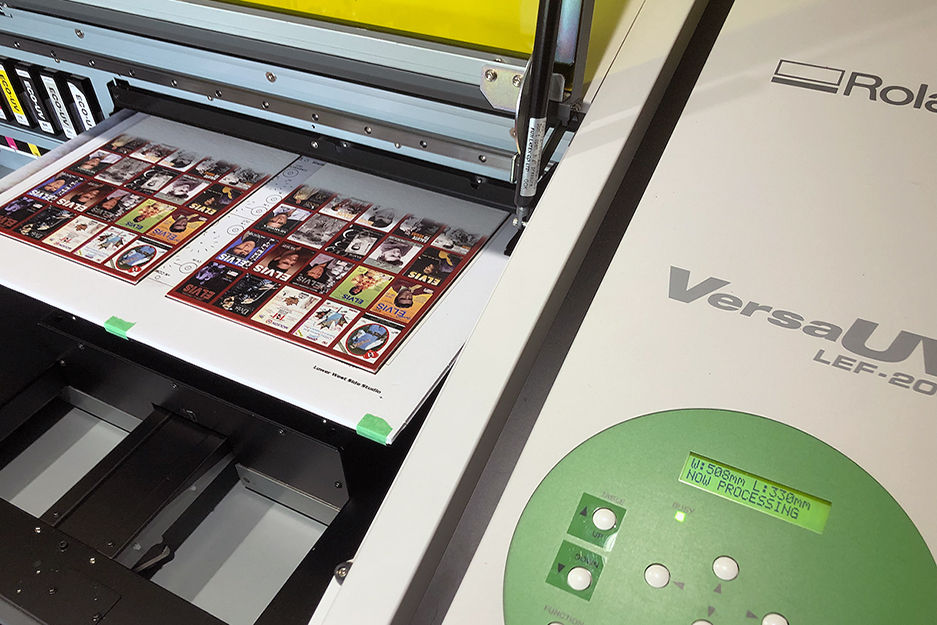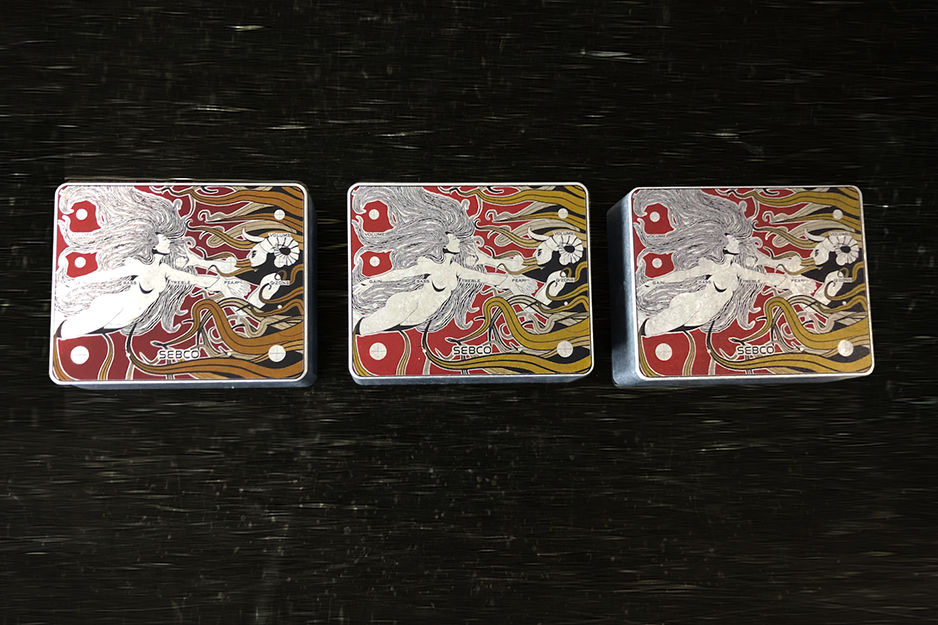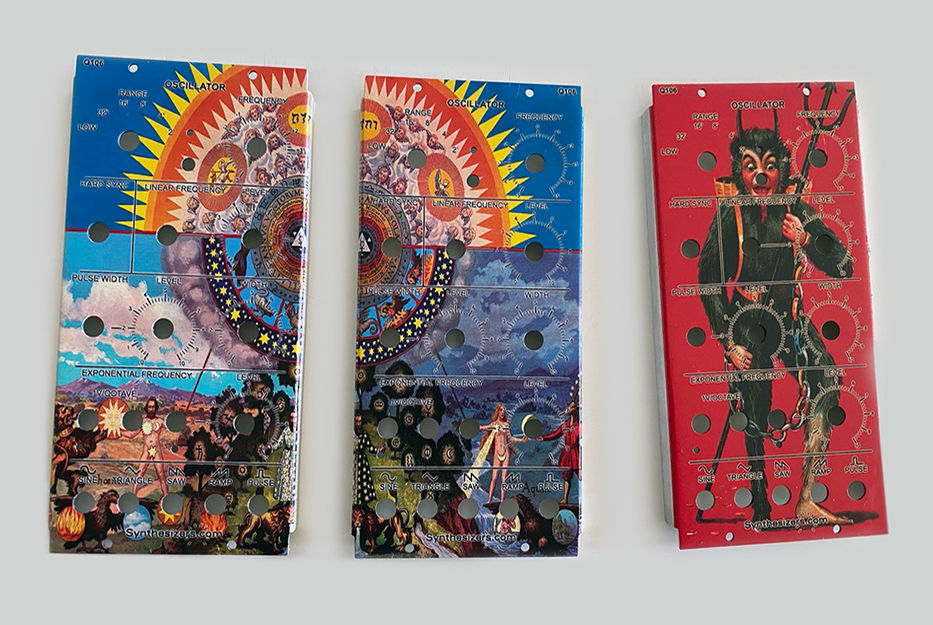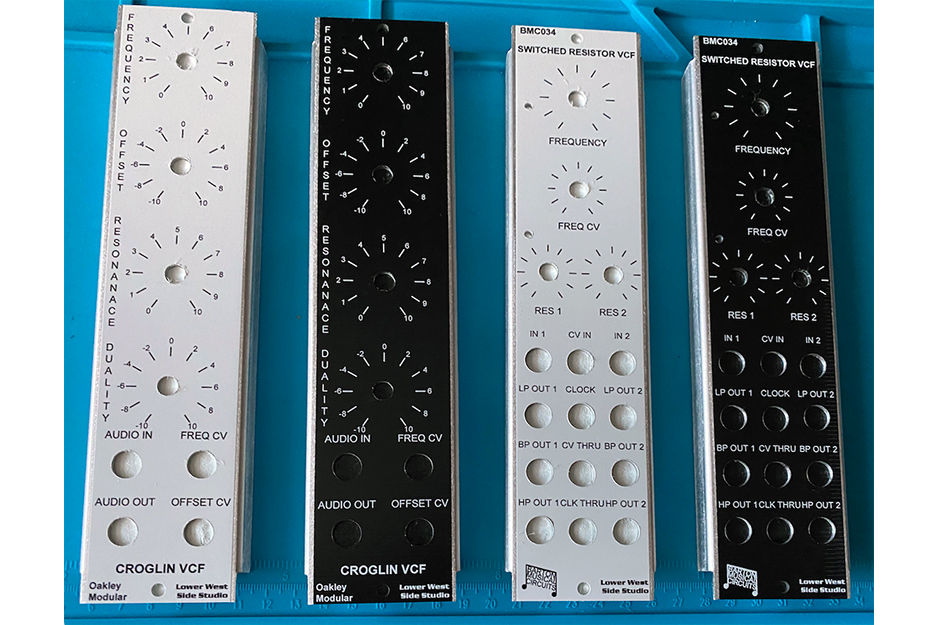Custom Printed Panels Make Music Beautiful
Lower West Side Studio | Collingwood, Ontario
Rich Sherkin nearly became a professional musician, but concerns about future financial security led him to focus on computers instead. After a long career in IT, he and his wife moved to Collingwood, Ontario, and he began making music again. In 2015, he assembled his own MU (Moog Unit) format synthesizer from a kit. Realizing that there was a market for assembling these units, he began selling them, calling his new company Lower West Side Studio.
To make his business stand out, Sherkin offered customized synthesizer unit panels. At first, he silk screened designs, but grew frustrated with the time-intensive process. Research on ways to apply graphics to metal led him to the Roland DG VersaUV LEF-200 UV flatbed printer and to Roland dealers Pam and Joe Daly at Daly Digital.
We spoke with Rich about how he started his business, how offering custom-printed synthesizer panels has helped his business grow, and about his unanticipated role in the popular annual Collingwood Elvis Festival.
How did you discover that synthesizer units could be the basis for your business?
I had been a drummer and played with keyboards and synthesizers in the 1970s when I was touring with local bands. In 2010, my wife and I moved to Collingwood, about 100 miles north of Toronto, and I started playing again.
Things were going well, and then, in 2016, I got the bug to build my own modular synthesizer – a big wall of electronic panels, with cables or “patches” linking one unit to another. These units are back in fashion now.
Word of mouth spread, and people started asking me if I could build units for them. The most difficult part of the unit assembly process is building the front panels. These panels are made of aluminum, and the Moog Unit (MU) synthesizer panels are bent in a way that makes them more difficult to deal with than some other types of modular synthesizer panels.
Why did you decide to move to UV printing?
Most manufacturers use silk screening to apply graphics to the panels. I researched the right ink, got the right mesh, and found the right light exposure to do emulsion silk screen. Unfortunately, silk screening is very time-intensive, and I could only do a few at a time without purchasing expensive equipment. It was a frustrating and slow process – often, I literally got nothing done by the end of a day. In addition, the ink was easy to smear, and it frequently ended up on my clothing.
As my products’ popularity increased, my limiting factors became the speed at which I could produce these panels, along with how intricate I could make the graphics. Most of my clients wanted black panels with white ink, but other people wanted very colorful images – even neon electric designs.
One day in 2019, I was faced with a large order that involved tons of silk screening. I said to myself, there has to be a better way. I researched how to print on metal and the first result was the Roland DG LEF series UV flatbed printer. I knew Roland DG from way back – my family is in the manufacturing business and we used Roland DG plotters. I watched a video online that showed the LEF printing, then set up an appointment with Pam and Joe at Daly Digital. They listened to what I needed, and we set up a time for me to bring in some panels and graphic files to do a test print on the LEF. The rest is history.
How did you get involved in Collingwood’s Elvis Festival?
When we moved to Collingwood, I joined a band, and our singer, John Gabriele, runs a printing house. Every year, he works with the town on the Collingwood Elvis Festival. When he heard I had this amazing new UV printer, he said “Hey, can you do some merch for the Elvis Festival?”
He brought over flip flops, jewelry boxes, keychains, coasters, and framed things – along with dozens of fully licensed pictures of “the King.” For more than two weeks, my basement looked like a shrine to Elvis. It was an interesting time. It was also a great way to learn about all the capabilities of the LEF. The vibrant graphics we printed made the King live on!
So that was how we got a handle on the LEF printing process. I started advertising that if people had graphics they wanted on their panels, they should contact us. With the LEF, I can print almost any design directly on panels quickly and easily.
What types of graphics are people asking for?
When we first began offering graphics, everyone wanted Darth Vader or the Death Star. I had to specify that trademarked and copyrighted artworks are not available. Also, every single person I talked to wanted me to print on something round, which the LEF can do. But the ability to print on metal panels is huge.
Panels are complex because of the variety of knobs and controls that are all over them. Clients will order modules from a place like Synthesizer.com and then send them to me for customizing. I sand the panels down and print new graphics them. If a customer isn’t happy with the way the manufacturer’s panel looks, I can change the appearance to his or her liking.
I get requests for solid color inversions, black on white, specialized designs and custom images. One panel in my personal synthesizer has a beautiful picture of my wife on it. That way she can keep her eye on me while I’m playing.
We have a customer in Germany who built 120 modules and came to us because he needed custom-printed panels for them. He sent us the panels pre-printed in his own shade of black, and wanted me to print the white text and the graphics he had designed on the panels. I was able to crank out the customized modules for him without any difficulty.
It sounds like there’s a lot of room for innovation and discovery in your business. How does the prototyping process work?
The printer is a huge timesaver for prototyping as well. With the LEF, I can go from concept to prototype in one hour – I’ve timed that on numerous occasions. I just sketch out a design, print the drill targets, drill the holes and then print the final front panel image. Presto. Try that with silk screening!
Having the ability to prototype quickly is also great for innovating. We are a community of inventors, but in the end, you have to get your ideas out of the box and into the real world. The ability to print quickly on the LEF makes cycling through the iterations of a prototype much faster.
One day, a customer named Adam noticed that a WTF oscillator designed by his friend Paula had ports on the back. He wondered if he could connect to the WTF unit with specific types of panels and fired me off a cocktail napkin drawing of what he had in mind. The next morning, I converted that into an image and ran four panels that afternoon – the printed panels were in the mail the next day. I was in the middle of tons of orders, but I can do a drawing while I have my coffee in the morning and print the prototype with my other panels in the afternoon.
Adam’s venture into this technology showed Paula that she had a WTF module opportunity, and she did a redesign of her module. It looks like Paula may release Adam’s design with our panels and it may be a whole new product for all of us.
Beyond all that though, as a computer guy, I really appreciate a machine like the LEF that just works. It’s enabled me to prototype and print quickly, which has impacted my business tremendously, increasing my production capabilities and providing a qualitative edge over the competition.
Who are some of your clients?
My clients include symphonic composers, music producers, film composers, DJs, club musicians – even a major media department. I look up some of these people online, and I’m amazed at what they have done. It’s thrilling to have my stuff going out to such accomplished performers.
The interesting thing about modular components is that you can have modules from different companies or producers in one synthesizer. With the precise printing I achieve on the LEF, my modules stand out – the blacks are so black and the whites are really vivid. Other producers can’t match the quality or the detail. I can print 1-point lines or even ½-point lines very precisely. This printer really rocks.
How is your company structured now?
It’s a one-man show, and I run the show. I have a panel guy and designer guy – all three of our companies work together. Because the LEF is a benchtop machine, I can work out of my home office. I also purchased the BOFA filter system, so there aren’t any odors.
At this point, we are (unofficially) the largest Canadian producer of MU (Moog Unit) format synthesizer modules. We sell over 100 modules per year and dozens of custom panels on top of that. The bulk of our clients are spread across North America and Europe, but we cater to some customers based as far away as Japan and Australia.
What lies ahead for Lower West Side Studio?
I’m really having fun with it all. This month, we are releasing an entire new line of synthesizer modules. We’re also continuing to expand. Now, we have panels pre-cut in bulk using lasers. We then print the panels and sell them to companies that offer DIY stuff. We’re hoping that one the largest sellers will pick them up.
I was speaking with my father recently, we concluded that there’s no way the company could have grown this quickly and effectively without the LEF-200. In his words, “Buying that printer was the best move we ever made.”
To make his business stand out, Sherkin offered customized synthesizer unit panels. At first, he silk screened designs, but grew frustrated with the time-intensive process. Research on ways to apply graphics to metal led him to the Roland DG VersaUV LEF-200 UV flatbed printer and to Roland dealers Pam and Joe Daly at Daly Digital.
We spoke with Rich about how he started his business, how offering custom-printed synthesizer panels has helped his business grow, and about his unanticipated role in the popular annual Collingwood Elvis Festival.
How did you discover that synthesizer units could be the basis for your business?
I had been a drummer and played with keyboards and synthesizers in the 1970s when I was touring with local bands. In 2010, my wife and I moved to Collingwood, about 100 miles north of Toronto, and I started playing again.
“With the LEF, I can go from concept to prototype in one hour ....Try that with silk screening!”
I spent my entire career in IT writing custom software systems for medicine and manufacturing, and I’m very familiar with electronics. In 2015 I decided to build a modular synthesizer from a kit. I realized there was a market for assembling these units, so I built extras and sold them on eBay.Things were going well, and then, in 2016, I got the bug to build my own modular synthesizer – a big wall of electronic panels, with cables or “patches” linking one unit to another. These units are back in fashion now.
Word of mouth spread, and people started asking me if I could build units for them. The most difficult part of the unit assembly process is building the front panels. These panels are made of aluminum, and the Moog Unit (MU) synthesizer panels are bent in a way that makes them more difficult to deal with than some other types of modular synthesizer panels.
Why did you decide to move to UV printing?
Most manufacturers use silk screening to apply graphics to the panels. I researched the right ink, got the right mesh, and found the right light exposure to do emulsion silk screen. Unfortunately, silk screening is very time-intensive, and I could only do a few at a time without purchasing expensive equipment. It was a frustrating and slow process – often, I literally got nothing done by the end of a day. In addition, the ink was easy to smear, and it frequently ended up on my clothing.
As my products’ popularity increased, my limiting factors became the speed at which I could produce these panels, along with how intricate I could make the graphics. Most of my clients wanted black panels with white ink, but other people wanted very colorful images – even neon electric designs.
One day in 2019, I was faced with a large order that involved tons of silk screening. I said to myself, there has to be a better way. I researched how to print on metal and the first result was the Roland DG LEF series UV flatbed printer. I knew Roland DG from way back – my family is in the manufacturing business and we used Roland DG plotters. I watched a video online that showed the LEF printing, then set up an appointment with Pam and Joe at Daly Digital. They listened to what I needed, and we set up a time for me to bring in some panels and graphic files to do a test print on the LEF. The rest is history.
How did you get involved in Collingwood’s Elvis Festival?
When we moved to Collingwood, I joined a band, and our singer, John Gabriele, runs a printing house. Every year, he works with the town on the Collingwood Elvis Festival. When he heard I had this amazing new UV printer, he said “Hey, can you do some merch for the Elvis Festival?”
He brought over flip flops, jewelry boxes, keychains, coasters, and framed things – along with dozens of fully licensed pictures of “the King.” For more than two weeks, my basement looked like a shrine to Elvis. It was an interesting time. It was also a great way to learn about all the capabilities of the LEF. The vibrant graphics we printed made the King live on!
So that was how we got a handle on the LEF printing process. I started advertising that if people had graphics they wanted on their panels, they should contact us. With the LEF, I can print almost any design directly on panels quickly and easily.
What types of graphics are people asking for?
When we first began offering graphics, everyone wanted Darth Vader or the Death Star. I had to specify that trademarked and copyrighted artworks are not available. Also, every single person I talked to wanted me to print on something round, which the LEF can do. But the ability to print on metal panels is huge.
Panels are complex because of the variety of knobs and controls that are all over them. Clients will order modules from a place like Synthesizer.com and then send them to me for customizing. I sand the panels down and print new graphics them. If a customer isn’t happy with the way the manufacturer’s panel looks, I can change the appearance to his or her liking.
I get requests for solid color inversions, black on white, specialized designs and custom images. One panel in my personal synthesizer has a beautiful picture of my wife on it. That way she can keep her eye on me while I’m playing.
We have a customer in Germany who built 120 modules and came to us because he needed custom-printed panels for them. He sent us the panels pre-printed in his own shade of black, and wanted me to print the white text and the graphics he had designed on the panels. I was able to crank out the customized modules for him without any difficulty.
It sounds like there’s a lot of room for innovation and discovery in your business. How does the prototyping process work?
The printer is a huge timesaver for prototyping as well. With the LEF, I can go from concept to prototype in one hour – I’ve timed that on numerous occasions. I just sketch out a design, print the drill targets, drill the holes and then print the final front panel image. Presto. Try that with silk screening!
Having the ability to prototype quickly is also great for innovating. We are a community of inventors, but in the end, you have to get your ideas out of the box and into the real world. The ability to print quickly on the LEF makes cycling through the iterations of a prototype much faster.
One day, a customer named Adam noticed that a WTF oscillator designed by his friend Paula had ports on the back. He wondered if he could connect to the WTF unit with specific types of panels and fired me off a cocktail napkin drawing of what he had in mind. The next morning, I converted that into an image and ran four panels that afternoon – the printed panels were in the mail the next day. I was in the middle of tons of orders, but I can do a drawing while I have my coffee in the morning and print the prototype with my other panels in the afternoon.
Adam’s venture into this technology showed Paula that she had a WTF module opportunity, and she did a redesign of her module. It looks like Paula may release Adam’s design with our panels and it may be a whole new product for all of us.
Beyond all that though, as a computer guy, I really appreciate a machine like the LEF that just works. It’s enabled me to prototype and print quickly, which has impacted my business tremendously, increasing my production capabilities and providing a qualitative edge over the competition.
Who are some of your clients?
My clients include symphonic composers, music producers, film composers, DJs, club musicians – even a major media department. I look up some of these people online, and I’m amazed at what they have done. It’s thrilling to have my stuff going out to such accomplished performers.
The interesting thing about modular components is that you can have modules from different companies or producers in one synthesizer. With the precise printing I achieve on the LEF, my modules stand out – the blacks are so black and the whites are really vivid. Other producers can’t match the quality or the detail. I can print 1-point lines or even ½-point lines very precisely. This printer really rocks.
How is your company structured now?
It’s a one-man show, and I run the show. I have a panel guy and designer guy – all three of our companies work together. Because the LEF is a benchtop machine, I can work out of my home office. I also purchased the BOFA filter system, so there aren’t any odors.
At this point, we are (unofficially) the largest Canadian producer of MU (Moog Unit) format synthesizer modules. We sell over 100 modules per year and dozens of custom panels on top of that. The bulk of our clients are spread across North America and Europe, but we cater to some customers based as far away as Japan and Australia.
What lies ahead for Lower West Side Studio?
I’m really having fun with it all. This month, we are releasing an entire new line of synthesizer modules. We’re also continuing to expand. Now, we have panels pre-cut in bulk using lasers. We then print the panels and sell them to companies that offer DIY stuff. We’re hoping that one the largest sellers will pick them up.
I was speaking with my father recently, we concluded that there’s no way the company could have grown this quickly and effectively without the LEF-200. In his words, “Buying that printer was the best move we ever made.”



